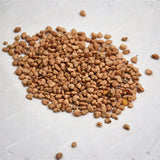The guava is highly adaptable to tropical and subtropical environments and can be grown outdoors as far North as the San Francisco Bay Area in California, as well as most areas of Florida and gulf coast states. Protect from temperatures below 30F, which can cause defoliation. Harder freezes will kill the plant. In cool winter areas, guava's may partially defoliate but should begin new growth flushes in spring and summer. It is easily pollinated by insects; in culture, mainly by the common honey bee, Apis mellifera.
Count: ~10
Family: Myrtaceae
Common name: Psidium guajava
Growing Environment
Label Psidium guajava
Common name Common guava
Family Myrtaceae
Genus Psidium
Species Psidium guajava
Cultivar No
Therapeutic uses No
Germination Owing to its hardy nature, guava is grown successfully in tropical and subtropical regions up to 1,500 m above mean sea level. Best quality guavas are obtained where low night temperatures (10 °C) prevail during winter. It tolerates high temperatures and drought conditions in North India during summers but it is susceptible to severe frost as it can kill the young plants. Annual rainfall of about 100 centimeters (39 in) is sufficient during the rainy season (July- September). The rains during the harvesting period, however, deteriorate the quality of fruits.
Guava is cultivated on varied types of soils- heavy clay to very light sandy soils. Nevertheless, very good quality guavas are produced in river basins. It tolerates a soil pH of 4.5-8.2. The maximum concentration of its feeding roots is available up to 25 cm soil depth. Thus the topsoil should be quite rich to provide enough nutrients for accelerating new growth which bears fruits.
Scarification / Stratification No
Count: ~10
Family: Myrtaceae
Common name: Psidium guajava
Growing Environment
Label Psidium guajava
Common name Common guava
Family Myrtaceae
Genus Psidium
Species Psidium guajava
Cultivar No
Therapeutic uses No
Germination Owing to its hardy nature, guava is grown successfully in tropical and subtropical regions up to 1,500 m above mean sea level. Best quality guavas are obtained where low night temperatures (10 °C) prevail during winter. It tolerates high temperatures and drought conditions in North India during summers but it is susceptible to severe frost as it can kill the young plants. Annual rainfall of about 100 centimeters (39 in) is sufficient during the rainy season (July- September). The rains during the harvesting period, however, deteriorate the quality of fruits.
Guava is cultivated on varied types of soils- heavy clay to very light sandy soils. Nevertheless, very good quality guavas are produced in river basins. It tolerates a soil pH of 4.5-8.2. The maximum concentration of its feeding roots is available up to 25 cm soil depth. Thus the topsoil should be quite rich to provide enough nutrients for accelerating new growth which bears fruits.
Scarification / Stratification No







